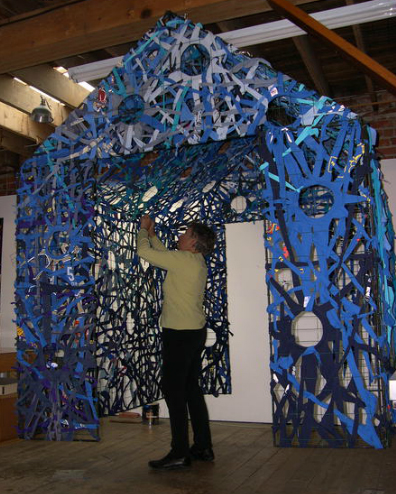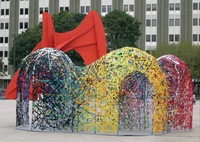Artist Margaret Parker reflects on her art and contribution to 'Percent for Art'

Local artist Margaret Parker weaves a cut-up t-shirt around a wire framed pillar for an upcoming art installation. Her studio is located above Downtown Home & Garden in downtown Ann Arbor. Chris Asadian | AnnArbor.com
-
 Local artist Margaret Parker weaves a cut-up t-shirt around a wire framed pillar for an upcoming art installation. Her studio is located above Downtown Home & Garden in downtown Ann Arbor. Chris Asadian | AnnArbor.com
/calendar/photologue/photos/web041312_ENT_Margaret_Parker_CA/cache/041312_ENT_Margaret_Parker_CA_001_fullsize.jpg
Local artist Margaret Parker weaves a cut-up t-shirt around a wire framed pillar for an upcoming art installation. Her studio is located above Downtown Home & Garden in downtown Ann Arbor. Chris Asadian | AnnArbor.com
/calendar/photologue/photos/web041312_ENT_Margaret_Parker_CA/cache/041312_ENT_Margaret_Parker_CA_001_fullsize.jpg
-
 Rough designs for the t-shirt wrapped pillars are tacked onto the wall. Chris Asadian | AnnArbor.com
/calendar/photologue/photos/web041312_ENT_Margaret_Parker_CA/cache/041312_ENT_Margaret_Parker_CA_002_fullsize.jpg
Rough designs for the t-shirt wrapped pillars are tacked onto the wall. Chris Asadian | AnnArbor.com
/calendar/photologue/photos/web041312_ENT_Margaret_Parker_CA/cache/041312_ENT_Margaret_Parker_CA_002_fullsize.jpg
-
 Margaret Parker splays out a t-shirt before cutting it into one long strip. Chris Asadian | AnnArbor.com
/calendar/photologue/photos/web041312_ENT_Margaret_Parker_CA/cache/041312_ENT_Margaret_Parker_CA_003_fullsize.jpg
Margaret Parker splays out a t-shirt before cutting it into one long strip. Chris Asadian | AnnArbor.com
/calendar/photologue/photos/web041312_ENT_Margaret_Parker_CA/cache/041312_ENT_Margaret_Parker_CA_003_fullsize.jpg
-
 Margaret Parker uses a method she devised to cut a t-shirt into one long strip. Chris Asadian | AnnArbor.com
/calendar/photologue/photos/web041312_ENT_Margaret_Parker_CA/cache/041312_ENT_Margaret_Parker_CA_004_fullsize.jpg
Margaret Parker uses a method she devised to cut a t-shirt into one long strip. Chris Asadian | AnnArbor.com
/calendar/photologue/photos/web041312_ENT_Margaret_Parker_CA/cache/041312_ENT_Margaret_Parker_CA_004_fullsize.jpg
-
 Margaret Parker sits at her desk in her studio. The piece adorning the wall, made from a tie-dyed t-shirt, is called 'Triple Orbits.' Chris Asadian | AnnArbor.com
/calendar/photologue/photos/web041312_ENT_Margaret_Parker_CA/cache/041312_ENT_Margaret_Parker_CA_005_fullsize.jpg
Margaret Parker sits at her desk in her studio. The piece adorning the wall, made from a tie-dyed t-shirt, is called 'Triple Orbits.' Chris Asadian | AnnArbor.com
/calendar/photologue/photos/web041312_ENT_Margaret_Parker_CA/cache/041312_ENT_Margaret_Parker_CA_005_fullsize.jpg
-
 Margaret Parker poses for a portrait near a segment of the 'Dream House' installation she made for the Ann Arbor Film Festival. Chris Asadian | AnnArbor.com
/calendar/photologue/photos/web041312_ENT_Margaret_Parker_CA/cache/041312_ENT_Margaret_Parker_CA_006_fullsize.jpg
Margaret Parker poses for a portrait near a segment of the 'Dream House' installation she made for the Ann Arbor Film Festival. Chris Asadian | AnnArbor.com
/calendar/photologue/photos/web041312_ENT_Margaret_Parker_CA/cache/041312_ENT_Margaret_Parker_CA_006_fullsize.jpg
-
 Margaret Parker poses adjacent to an unfinished art installation that she is currently working on. Chris Asadian | AnnArbor.com
/calendar/photologue/photos/web041312_ENT_Margaret_Parker_CA/cache/041312_ENT_Margaret_Parker_CA_007_fullsize.jpg
Margaret Parker poses adjacent to an unfinished art installation that she is currently working on. Chris Asadian | AnnArbor.com
/calendar/photologue/photos/web041312_ENT_Margaret_Parker_CA/cache/041312_ENT_Margaret_Parker_CA_007_fullsize.jpg
After dedicating a lot of time and effort to Ann Arbor’s Public Art Commission over the past decade as a commissioner and former chair, local artist Margaret Parker is happy to turn all of her focus to her own art now. At a turning point in her career, she is excited about her newest artworks and says her past effort to bring a “Percent for Art” program to Ann Arbor “has been my biggest accomplishment, so far.”
Parker and other AAPAC commissioners were under public scrutiny—both praised and criticized—for encouraging the City Council to adopt an ordinance in 2007 that sets aside 1 percent of the budget for all capital improvement projects for public art. Up to $250,000 can be spent on a project. The City’s purchase of the water sculpture installed at the new municipal center by famous German artist Herbert Dreiseitl sparked particular debate.
Parker’s opinion on the matter is clear: She is all about setting aside money for more public art in Ann Arbor. “It’s way too easy to cut the arts. People question its value. But things that make you think and feel, and art that expresses what your community is about is invaluable,” she says.
“What I loved about it was that there we were in City Council chambers having a big discussion about art. Everyone took it seriously, and no one said they didn’t want public art. There are some who didn’t want the public to pay for it.” she explains.
Her interest in advocating for public art began decades ago, when she and her husband, Downtown Home and Garden owner Mark Hodesh, lived in Maine. The U-M art school graduate was doing murals at the time. “Maine had a statewide percent for art program, so I went to the state to find out how to get involved,” she says. When the couple moved back in Ann Arbor, she started looking for funding opportunities.
“I was on the Public Art Commission in one way or another for over 10 years. I felt really strongly about art, and I found out that I was good at talking about it. I feel strongly that art shouldn’t only be in galleries. It should be where everyone can see it,” Parker says.
These days, Parker is taking what she learned from her stint on the commission and applying it to furthering her own career as a fine artist.

Ann Arbor artist Margaret Parker works on her piece 'Dream House'
In "Dream House," blue T-shirts are woven around a wire frame resembling a house. The installation is large enough to walk through. A 30-minute video fills the floor.
“The piece is about the foreclosure crisis. With a lot of my work, I’m interested in how everyday people fit into larger social constructions, even crises. This one is all about how foreclosure makes people feel and a lack of control over what is happening to you,” she explains.
The video includes a number of different elements that together juxtapose the dreams that people have about what home means to them and the threat of losing it all. She assembled it with the help of Joey Ostranger, Brian Schmidt, and Shoshana Hurand, and musician Ken Kozora provided the score.
For part of the film, Parker toured foreclosed houses in Washtenaw County “looking for evidence of fairy tales,” like a glass slipper she found left behind on a windowsill. Another piece of footage she uses is of her and her grown daughter playing with a doll house.
Parker also collaborated with young people at 826Michigan who took a workshop taught by Hurand and Onna Solomon. The kids wrote stories about home. The film’s soundtrack includes some of the kids reading their stories aloud—what home means to them, their best memories, and their scariest moments.
The video also has water imagery scattered throughout. “The water imagery builds up and gets more intense over time. It starts with footsteps in the snow, then light rain, then it starts washing down fast, it becomes a river, and finally you see water falling in a dam. It's like the effects of the foreclosure crisis. It starts small and you do the best you can, but he gets faster and faster and pretty soon you can't stop the flood,” Parker says.

The artist recently returned from a trip to Los Angeles, where her artwork, "Kali: she who destroys regenerates," was on exhibit. The exhibition, “Momentum,” celebrated the 40th anniversary of the Women’s Caucus for Art and the women’s movement. The show was a part of a region wide show, “Pacific Standard Time,” and held at the Los Angeles Art Association / 825 Gallery.
"Kali: she who destroys regenerates" consists of stripped T-shirts shaped like a burst. It is an example of one of several of her pieces that she installs in the corner of rooms. “T-shirts always suggest a person to me. In the case of "Kali," Americans always want everything bigger. Bigger is better. So, the strips of t-shirt expand outward. But the piece, like many Americans, also feels like it’s backed into a corner at the same time,” she explains.
Parker has worked in a number of different media over the years—paint, charcoal, prints, terracotta and bronze just to name a few. When she finds a materials she likes to work with, she has a tendency to create a bunch of artworks with it in a row. For her next T-shirt works, she is going to experiment with making smaller pieces.
View more of Margaret Parker’s artworks and find out more about the artist on her website, www.margaretparkerstudio.com Parker is currently working on a temporary installation that will be part of an outdoor show in East Lansing to usher in MSU's Broad Art Museum, "Broad Without Walls," which will be up in East Lansing from April 28-May 8. More information: broadmuseum.msu.edu/events/BroadwoWalls.php


 The Lunch Room does vegan food in a way that even non-vegans can enjoy
The Lunch Room does vegan food in a way that even non-vegans can enjoy Images from Dawn Farm's 40th Anniversary Jamboree
Images from Dawn Farm's 40th Anniversary Jamboree See photos from Kerrytown BookFest
See photos from Kerrytown BookFest Images from Michigan's 41-30 win over Notre Dame under the lights
Images from Michigan's 41-30 win over Notre Dame under the lights
Comments
pegret
Thu, Apr 19, 2012 : 6:10 p.m.
What, only 1 mention about hubby, and no plugs for Mark's Carts, Zingerman's, or Domino's? Tell me....I know with the Observer, it's all about their advertisers, but what does one have to do to get so much free publicity from A2.com?
Jennifer Eberbach
Wed, Apr 25, 2012 : 12:45 a.m.
I'm not sure I totally understand your comment. My entertainment stories aren't advertisements, so I don't do "plugs" unless they directly relate to the sentences I write. Mark's Carts is great, BTW. To answer your question, I give "free publicity" to anyone with a compelling story that can be done within publishing deadlines. Just to clarify.
pseudo
Wed, Apr 18, 2012 : 3:07 p.m.
Wow, I almost don't want to comment based on the comments already here. I am not hostile to art in general and I'm not hostile to art in public places. However, Art funded by the public has several layers of conflict that, I believe, should be very very carefully considered when spending the public's money. First is the inherent subjective nature - this ensures that "the public" as a whole will never be happy with a particular piece of art and if put of for a vote, public money would rarely be spent on art. The second layer is that if you TAX development for the purposes of installing more public art the compulsory nature of that tax is inherently problematic. Its one thing for a city to step up to spending the public's money on a piece or two - its quite another to levy a TAX (1% for Art) and then turn that money over to a commission of political appointees to spend that pool of money. Given the controversey over the 1% for Art program as it stands. I do not think the public should be in the business of funding art given these conflicts. Nor would I want to be an artist trying to please a public who has commissioned a piece of art. As for the answer of If not "the public" then who would fund art - I point to the history of artistic expression through out the world. Art will happen.
Jennifer Eberbach
Wed, Apr 25, 2012 : 1:10 a.m.
I really like that you spelled out your ideas. You hit on important points, even when I disagree. The question of whether or not everyone likes a particular piece of art such as the water fountain is a big one, especially because the City paid for it. But I think the question is bigger than that. Do we value art, at least at 1%? We are known throughout the world as an art town. My prediction is that you will eventually get pieces of public art that you like. You might also get some you don't like. But someone will like them.
justcurious
Wed, Apr 18, 2012 : 2:31 p.m.
No words can express ....... ah, it's just not worth any words.
Chip Reed
Wed, Apr 18, 2012 : 12:39 p.m.
If art is to make people "think and feel", then by that standard, the water sculpture is a big success.
Alan Goldsmith
Wed, Apr 18, 2012 : 10:51 a.m.
"For part of the film, Parker toured foreclosed houses in Washtenaw County "looking for evidence of fairy tales," like a glass slipper she found left behind on a windowsill." Gag me.
Alan Goldsmith
Wed, Apr 18, 2012 : 10:50 a.m.
""The piece is about the foreclosure crisis. With a lot of my work, I'm interested in how everyday people fit into larger social constructions, even crises. This one is all about how foreclosure makes people feel and a lack of control over what is happening to you," she explains." Nothing quite like one of the One Per Cent of Ann Arborites creating 'art' about the lower and middle class being tossed from their homes and pretending like it's not an insulting hypocritical cliche. Art and the City are better off with Ms. Parker's departure from the AAPAC.
Jennifer Eberbach
Wed, Apr 25, 2012 : 12:20 a.m.
Advocating for art doesn't make you the 1%, nor does it push anyone out of their homes. You can disagree with the ordinance, but please recognize that it is a complex issue.
mixmaster
Wed, Apr 18, 2012 : 9:55 a.m.
There is nothing more boring that talking about art. It's a game for elitists and snobs. I think her work is overwrought and pretentious.
Jennifer Eberbach
Wed, Apr 25, 2012 : 12:05 a.m.
I don't think art is boring, so I think I'll keep writing about it.